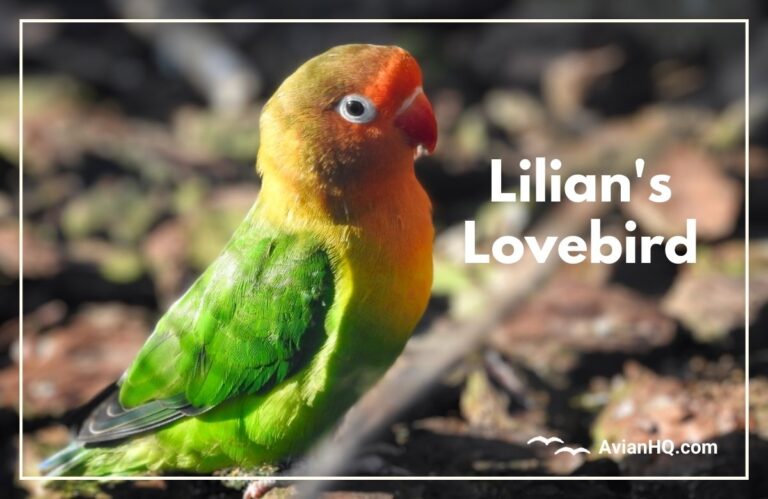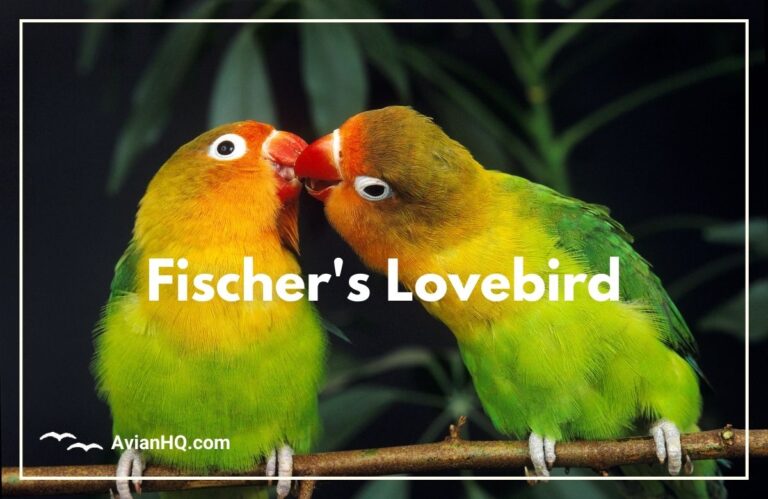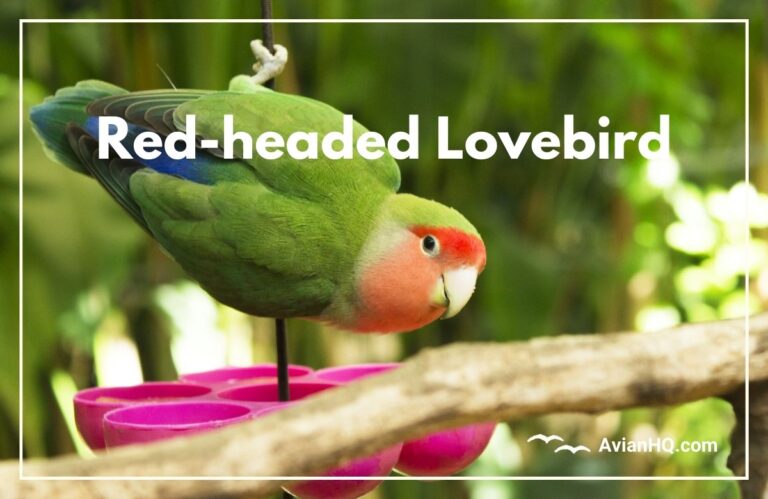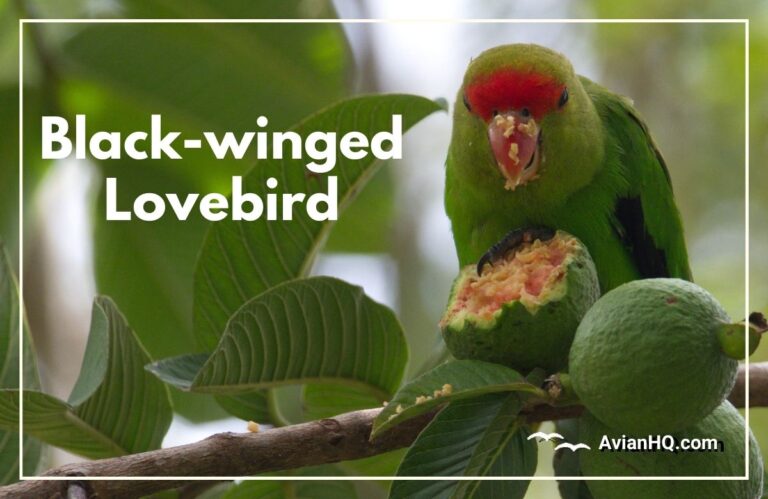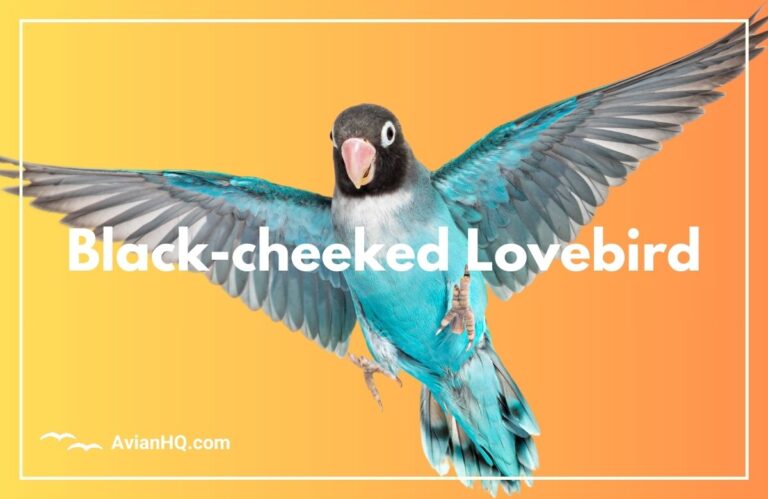Yellow-collared Lovebird (Agapornis personatus)
You gaze out at the flock of small green parrots fluttering among the acacia trees. As they alight on branches and forage for seeds, a flash of bright yellow catches your eye. Several of the parrots sport a vibrant golden band across their chests and necks that seems to glow in the afternoon sunlight. These colorful accents set them apart from other parakeet species in the area. You are watching a flock of Yellow-collared Lovebirds!
Native to the grasslands and woodlands of central and northern Tanzania in East Africa, the Yellow-collared Lovebird (Agapornis personatus) is a beautiful small parrot distinguished by its golden bib and namesake collar. Though similar in size and shape to other lovebirds, the Yellow-collared Lovebird stands out with its vibrant yellow neck ring contrasting sharply with green plumage. When seen up close, additional distinctive features come into focus like its bright red beak, white eye-rings, and black mask.
While many parrot species form monogamous breeding pairs, Yellow-collared Lovebirds live up to their name by forming exceptionally strong bonds between mates. These partnerships persist from one breeding season to the next. Flocks may contain just a few pairs or number over 100 birds at prime foraging grounds. Read on to learn more about the natural history, physical description, conservation efforts and cultural significance of this African lovebird.
History and Taxonomy
The Yellow-collared Lovebird remained unknown to science until the late 19th century, first being described in 1887 by German ornithologist Anton Reichenow. Its scientific name comes from the Greek words “agapornis” meaning loving bird and the Latin “personatus” referring to the facial mask.
This lovebird is a monotypic species, with no recognized subspecies. Some color mutations have arisen in captivity like blue, violet, albino and pied. Interestingly, the blue mutation traces back to wild caught specimens in the 1920s and represents the oldest color variety among all lovebird species.
The species is classified within the parrot family Psittacidae, specifically placing it in the lovebird genus Agapornis. Eight other lovebird species join it there, all native to Sub-Saharan Africa except one species from Madagascar. Experts typically group this genus into three types – the eye-ringed lovebirds with white rings like A. personatus, the white-eyed lovebirds lacking eye rings, and the Madagascar lovebird (A. cana) which stands alone.
Physical Appearance
The Yellow-collared Lovebird measures approximately 14.5 centimeters (5.7 inches) long with a wingspan around 9-10.5 centimeters (3.5-4.1 inches). It weighs roughly 50 grams (1.8 ounces).
As its name suggests, one of the most distinguishing features is the vibrant yellow bib and collar stretching across the bird’s neck and chest. The neck ring forms a complete circular collar, while the yellow on the chest tapers to a point below.
The lovebird’s upperparts are olive green, with darker shades overlaying its back and wings versus the brighter yellow-tinged green on its rump and upper tail. The undertail coverts match the yellow bib in color. Its lower breast and belly are a lighter green to complete its main color palette.
It sports a dramatic black head and face masks with stark white rings circling each eye. Its short broad bill is a bright cherry red. Legs and feet are a solid gray with black nails on each toe.
Male and female Yellow-collared Lovebirds have identical external plumage with no sexual dimorphism. Juveniles look similar but a touch duller on the head and their upper mandible is partially black at the base as they mature.
Habitat and Distribution
The Yellow-collared Lovebird naturally occurs in a broad swath of central and northern Tanzania in East Africa. Its range centers on the Arusha region but stretches across inland plateaus and savannas to the shores of the Indian Ocean.
This species mainly inhabits open grassland habitats dotted with scattered trees, especially Acacia and Baobab tree species. It tends to avoid densely forested areas as well as thick scrubland terrain. The lovebird has been observed at elevations spanning from sea level up to 1,800 meters (5,900 feet).
Though native to Tanzania, small introduced populations have become established in recent decades in Burundi and Kenya. The species has also been sighted in isolated cases in Puerto Rico, the United States, France and New Zealand as likely escapees from the pet trade or aviculture, but no stable reproductive populations exist in these areas.
Diet and Feeding
The Yellow-collared Lovebird is mainly granivorous, feeding primarily on seeds from native grasses, agricultural grains and other plants. Flocks forage among the seed heads of grass stalks across extensive terrain.
It supplements its grass seed diet with other vegetation including sprouting plants, fruits, buds, figs, and fresh green leaves. Their strong beaks allow them to crack into these plant foods.
The lovebirds may also nibble on grit or dirt to aid digestion similar to other parrots. They have been known to raid cultivated fields, attacking crops like millet and sorghum when wild grass seeds are scarce.
Foraging flocks range widely while feeding, covering expansive areas in flight as they seek out preferred food sources. Typical flock sizes range from small family groups of 4-5 birds up to aggregations of 100 or more around plentiful seed stocks. Their feeding behaviors help disperse undigested seeds across their native habitat.
In captivity, these lovebirds thrive on a quality seed mix containing millet, oats, canary grass and sunflower seeds. Supplements like fruits, leafy greens, sprouts and pellets round out their diet. Clean, fresh water must be available at all times in dishes secured to cage sides.
Breeding and Reproduction
The Yellow-collared Lovebird breeds in colonies during the dry season from March to August in its East African habitat. Though normally seen in small flocks, breeding aggregations can contain hundreds of birds.
They choose nesting sites in the holes and cavities of both dead trees and within cliffs and rocky outcroppings. The female builds an enclosed, domed nest using strips of bark and small twigs as construction materials. She carries bundles back in her beak, weaving them into a complete enclosure.
A typical clutch contains 4-5 oval shaped white eggs. The female incubates these small eggs alone for 21-23 days before they hatch. Both parents share duties feeding the chicks regurgitated seeds. Nestlings fledge at around 41-45 days old.
In captivity, specially made nest boxes should be provided to allow breeding. These sturdy boxes measure about 8 inches (20 cm) per side and have a rear entry hole 2-3 inches wide. Place dried grasses inside and hang securely within the aviary or cage. Parents will likely lay eggs even without a nest but need materials to encourage natural behavior. The average lifespan in captivity spans 10-15 years with proper care.
Behavior and Ecology
The Yellow-collared Lovebird derives its common name from the exceptionally strong pair bonds formed between mated pairs. These partnerships endure across breeding seasons. Their fidelity inspired lovebirds’ romantic associations in human culture.
Flocks range dramatically in size throughout the year. Small family groups of just 4-5 birds may be observed foraging together. However, at plentiful food sources or colony nest sites, aggregations of up to 100 Yellow-collared Lovebirds have been recorded.
Though active and social by day, the lovebirds grow quieter in evening hours before roosting for the night. They rarely sleep openly, instead wedging themselves into small crevices among tree branches or cliff faces that provide cover. Their yellow and green plumage blends into vegetation, camouflaging them from predators.
Lovebirds play a key ecological role in their native habitat by dispersing undigested seeds across the landscape. Their high mobility powers this transportation process as large flocks range widely while feeding then scatter droppings full of viable seeds as they move. This helps germinate native plants.
Their instinct to chew and shred various materials also facilitates nest building. Females carrying bits of bark and dried grass aid wider materials recycling and redistribute nesting resources within their environment. Their small size limits risks of significant damage, unlike much larger parrot species.
No specialized relationships or interdependencies between Yellow-collared Lovebirds and other species have been documented. Their minor crop raiding draws some conflict with agriculture, but otherwise they fill their niche among Africa’s diverse birdlife without issue.
Conservation Status
The Yellow-collared Lovebird is evaluated as Least Concern on the IUCN Red List of Threatened Species. Though its global population numbers have not been quantified, the species is suspected to have a stable overall population in the absence of substantial threats.
Its extensive native range covers over 123,000 square miles across Tanzania’s central plateau down through coastal areas. No major habitat losses or declining trends have been observed across this range. Ongoing monitoring helps ensure quick intervention if threats arise.
Small introduced populations now present in Burundi, Kenya and elsewhere come from accidental or intentional releases of pets, not through natural range expansion. No conservation risks are linked to these non-native groups. Illegal capture for the pet trade is combated by restrictions on export under CITES Appendix II which requires permits be issued sustainably.
In captivity, Yellow-collared Lovebirds are fortunately still common as pets and among avicultural collections. Their vibrant colors and social bonds remain attractive. Care does require proper research however to meet their needs for space, nutrition and mental engagement. Providing an adequate healthy diet free of vitamin deficiencies and creating opportunities for bathing, exercise and chewing minimize health issues. With good care, captive lifespans range up to 15-20 years.
Cultural Significance
The Yellow-collared Lovebird contributes to human culture in a variety of ways despite its remote African habitat. As a brightly colored and active parrot species capable of forging exceptionally strong social bonds between mates, the lovebird carries broad symbolic importance.
Its playful and affectionate nature when tamed or kept captive has fueled global interest from bird enthusiasts, breeders and the pet industry for over a century. Demand remains high. Selective captive breeding has produced a range of color mutations over the years. Albinos, lutinos, violets and more now occur beyond their wild green and yellow forms.
This species helped inspire the wider cultural associations linking lovebirds with affection and romantic partnerships. Giving lovebirds as gifts or artwork motifs promotes these connections through symbolic meaning tied to their monogamy and lifelong bonds. Lovebirds often mate for life.
Unfortunately, unsustainable or unethical capture of wild lovebirds for export also occurs in some areas. Conservation education aims to boost captive breeding efforts to supply markets ethically and curb detrimental practices that could impact native ecosystems. Campaigns highlight care standards promote responsible lovebird ownership.
As flagship species, their visibility and significance provides a gateway to engage broader audiences with conservation values and best practices for avian husbandry. Their cultural meanings offer useful touchpoints allowing environmental outreach programs to inspire support for African ecosystems they call home.
Conclusion
The vibrant yellow bib and neck collar of the Yellow-collared Lovebird make it one of the most uniquely decorated parrots among the nine African lovebird species. Beyond its aesthetically eye-catching plumage, we have explored various facets of its natural history from feeding ecology to bonding behaviors revealing why this lovebird truly lives up to its evocative common name.
Through each section we’ve studied notable aspects of its taxonomy, physical traits, habitat use, reproduction strategies, conservation status and cultural symbolism tied back to two core themes – its African identity and the passionate partnerships fused between life partners. Love drives both their nurturing of chicks and loyalty across years seldom separated from their mate’s side. Monogamy is embedded within social structures.
While human cultural attachments impose certain unrealistic romantic expectations onto these small parrots, genuine affection flows strongly within flocks from breeding colonies sheltering 100 nesting pairs down to little family groups of five fluttering between perches. Their visibility and stamina even amidst unfamiliar territories like suburban Arizona or Puerto Rico testifies to success as adaptive opportunists despite facing threats across Africa’s grasslands and woodlands.
Our exploration of the Yellow-collared Lovebird also opened considerations of broader conservation values and ethics concerning captive species. Ensuring sustainable management informs exports amidst high ornamental pet demand while habitat integrity is preserved locally against overharvest deserves ongoing engagement from policy makers, scientists and enthusiasts alike. Providing adequate healthy living conditions under human care requires education and resources too, prioritizing the animal itself over solely aesthetic preferences. Life partners merit joint welfare. If lovebirds give such premiums to companionship, perhaps greater society has lessons to gain from them as well.


